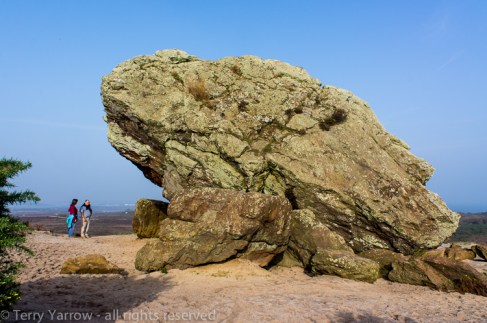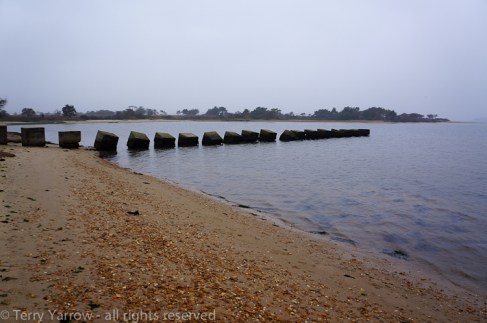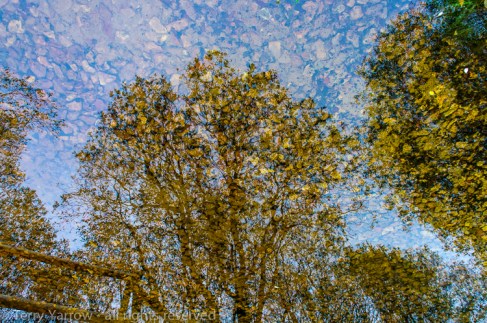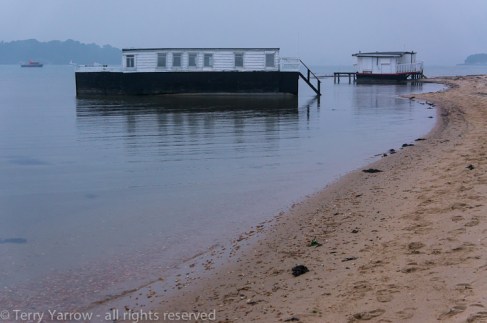I think we all like walking in the lovely bright summer sunshine, but I’m a strange person in that I like to walk in all weathers! In fact there are times when bad weather really improves a walk – for instance, on a bright summers day mountains can seem quite tame but bring down some stormy weather and they take on a whole different character, much more threatening and dangerous. On this walk, the day was very misty and with heavy cloud that really suited the landscape so well, as I think you will see.
It started with a walk around the southern shore of Poole Harbour, said to be the second largest natural harbour in the world with 100 miles of coastline. Initially, the walk was straight forward with sandy beaches, gently lapping water, and……and house boats!

The house boats at Bramble Bush Bay
These always intrigue me as some are not really boats at all – because they were effectively falling apart, they have been embedded in concrete to ‘stop the rot’. They still lean at crazy angles and you would be justified in thinking they were derelict, but they are not. They are still occupied in the summer months when the concrete bedded ones are joined by a number of additional floating houses to form a village by the beach. It is one of those quirky things of Dorset that I have known all my life.
A little further on in my walk I came across another of those mysteries, a row of dragon’s teeth – but are they?
This line of heavy concrete blocks stretches a short distance into the harbour’s water and are usually referred to as Dragon’s Teeth, a wartime anti-tank blockade, but I often wonder if that really was their purpose. At one time, Brownsea Island, the largest island in the harbour, had a pottery industry and raw materials were transported by boat to the island, and in turn, the pottery goods were exported. To do this, the barges used to berth at a number of landing stages on the harbour shore and I wonder if these blocks are the remains of one of these. I have never been able to totally prove one way or the other but in many ways, it is the very mystery that makes these utilitarian blocks fascinating.
Continuing round the shoreline, I passed below the beautiful low sandstone cliffs with their amazing array of warm colours ranging from yellow, through the whole spectrum of oranges, to deep browns. And below, the sandy beach begins to turn a little more rugged.
There is quite a lot of debris along this part of the coast, remains from the days when there were thriving industries. This is very evident at Redhorn Quay. The old jetty itself has long since disappeared but there is a rusting hulk, still standing proud, determined to hold out till the last. I fear it will not be there much longer as the weather over the years has destroyed most of it already.
I always linger at Redhorn because as you stand there with the wind whipping around you and the sound of the sea lapping on the shore, you can almost sense what it would have been like all those years ago when the wreck was a working barge plying its trade around the harbour. With other derelict vessels nearby, it feels like a graveyard.
But it was time to move on. Now this is not an easy walk and in some ways that is what makes it special because it is not frequented by many people. This makes it seem all the more remote. What makes the walk difficult is that it is extremely marshy and great care is needed to avoid stepping in the wrong place! But it has a very beautiful loneliness about it. With the heavy mist and cloud, the marshes take on real character as you walk carefully beside the water. The tide was out revealing vast expanses of mud flats which were frequented by a whole range of waders, and their plaintive cries echoing across the harbour just emphasised the feeling of loneliness that this area evokes. I love those plaintive cries, especially that of the curlew and the oyster catcher!

Marshes and mud flats in Poole Harbour
I lingered as long as I could but had to move on because there was a lot more to enjoy on this walk. As I left the harbour shore, I took one last look back across the wonderful autumn marsh grass.
From the marshlands of the harbour, I walked on across the heathland further inland, with its famous Agglestone (holy stone). This stone stands proud on its hilltop as if it was monarch of all he surveys…..but the truth is it is not meant to be there! It is a massive block of sandstone, not necessarily massive by world standards but massive in the context of the sandy heathland that surrounds it. It is this incongruity which makes it another of Dorset’s curiosities. Legend has it that it was thrown by the devil from the Isle of Wight when he was aiming to destroy Corfe Castle which is a few miles away. Clearly his aim was not that good…….or maybe it is just that it is a relic of the ice age ;)!

The Agglestone on Godlingston Heath
One of the things I like about this walk is the varied terrain, from marshes to heathland and on to much more civilised ground as I crossed the well manicured grass of Isle of Purbeck Golf Course, famed for being owned by Enid Blyton. Even here though there was wetness!!!

Tracks in the wet grass on the Isle of Purbeck Golf Course
And having passed across the fairway, watching for low flying golf balls ;), my route took me up over to the top of Ballard Down with its well known obelisk looming out of the mist. This obelisk was erected for the first time in 1883 to commemorate the coming of a clean water supply to Swanage. I say ‘for the first time’ because it was taken down during the Second World War to prevent its being used by enemy pilots to aid navigation. It was erected for a second time in 1952 but somewhat shorter because the bottom section had been damaged.

The ‘shorter’ obelisk on Ballard Down
The view from the obelisk is wonderful and it was a view that stayed with me as my route followed the ridge for several miles. Normally on this part of the walk I would be serenaded by skylarks but not on this day. I did however come across some fungi, grouped together as if they were deliberately posing for a family photograph. Naturally I obliged ;)!

A fungi family gathering on Ballard Down
Having enjoyed the spectacular views…..and the bracing wind……on the ridge top, I eventually dropped down into the valley again to pass through a farm with the usual array of ‘abandoned’ farm machinery. Some of this was clearly just parked until needed again but it always amuses me how much machinery simply gets left to rust away. On some walks it almost seems like someone has deliberately set up a museum of farming through the ages!
I was nearing the end of my walk now but there was still time to look for some more pictures. I like to look for a different view of things and recently have been searching for what I call ‘alternative autumn pictures’. I found one on this walk in a river bed which reflected the trees above – the ‘autumn leaves’ were in fact pebbles under the water.
The final stretch of this wonderful and varied walk should have taken me along the beach back to my starting point but I took a detour to revisit the early part of my walk again, hoping for an amazingly vibrant sunset across the Dragon’s Teeth and house boats – but as often happens it didn’t come!! Well I guess the sun did set, but hidden from view behind a huge bank of cloud! Ah well, I took the pictures anyway.
Somehow, in the fading light, the random concrete blocks seem even more imposing.

Poole Harbour in the fading light
And standing on the shore on this crisp evening with the water gently washing across the sand with the mist still lingering across the harbour, there was a special atmosphere. It is what makes walking so enjoyable and memorable!

Darkness falls on The Bramble Bush Bay houseboats
By the time I reached the Sandbanks Chain Ferry for my trip back across the Poole Harbour entrance, it was dark – but then, I finish nearly all of my walks in the dark….just to make them last a little longer. And this was a walk I didn’t want to end.
Not much sun, lots of cloud and mist, chill breezes, waders and fungi, marshland, heath, hilltops and beach, and a good smattering of Dorset quirkiness – a wonderfully varied and evocative walk. I hope you enjoyed walking it with me.
Thanks for stopping by and reading the ramblings of The Dorset Rambler.
Until next time,
Your friend
The Dorset Rambler.
If you would like to contact me, my details are on my website which is http://www.yarrowphotography.com – comments and feedback are welcomed.
All photographs, poems and words in this blog are the copyright of The Dorset Rambler and must not be reproduced without permission.















Wow! I love the “autumns int he riverbed” and “rusting hulk” photos. All are amazing!.
Thanks Alice 🙂
Fond memories of the Sandbanks chain ferry when we lived in Swanage. I was waiting for it one night around 10.00pm, it was very dark and the ferry glided silently past on its way to France, lights ablaze. What song started playing on the radio at that moment? The theme to Titanic – very apt 🙂
Ha ha, love it! Glad I wasn’t on that ferry ;))
I can almost smell the water and hear the cries of the birds. I like the rusting hulk photo too — it makes me wonder what it looked like when it was new and what were the backstories of the people that were on that boat.
Thanks EEE 🙂
Oh, I love so many of these, it’s hard to know where to begin! I think Agglestone looks like a huge pre-historic turtle. And the ‘Autumn in the Riverbed’ is totally without comparison! You have done it again: given us a truly delightful and adventurous journey. Thanks so much.
Aww, thanks Sandra, you are very kind 🙂 Interesting, you are not the first to comment on the ‘autumn in the riverbed’ picture – hmm, must be something in it. Agglestone has been described as a frog but I can see a turtle as well. It was once flat on top, sort of anvil shaped, but erosion caused it to roll over. Bless you.